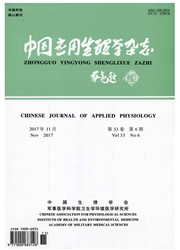

 中文摘要:
中文摘要:
目的:拟从基因多态性角度探索人类个体低氧训练效果差异性的分子生物学机制。方法:选取41名健康受试者在模拟海拔2500m高度进行4周“高住-高练-低训”(低氧暴露10h/d,3次70%VO2max低氧训练/周,共4周),观察低氧诱导因子-1α基因(HIF-1α)C1772T多态性、内皮型一氧化氮合酶基因(eNOS)第4内含子27bp(4b/a)可变数目重复性多态性(VNTR)与低氧训练期间最大摄氧量(VO2max)、血红蛋白(Hb)、红细胞数(RBC)及血氧饱和度(SpaO2)等生理指标变化的关联性。结果:携带CT基因型和CT+ba复合基因型的受试者,4周低氧训练后△VO2max显著增加(P〈0.05),CT基因型受试者低氧训练前、后△RBC,△Hb无显著性差异,但较其它基因型相比,表现出升高趋势;CT基因型与ba基因型受试者在低氧定量负荷实验中,SpaO2表现出高于其它基因型的趋势,但无显著性差异。结论:HIF-1α基因C1772T多态性及eNOS基因4b/a多态性可能与低氧训练效果及低氧环境下适应能力的个体差异性有关,CT基因型及CF5ba复合基因在低氧适应能力上具有一定的优势。
 英文摘要:
英文摘要:
To investigated association between polymorphisms of HIF-1α, eNOS genes and individual variation in response to intermittent hypoxia training. Methods: 41 health subjects, completed 4 weeks hypoxia training program(hypoxia exposure 10 h each day and 3 times hypoxia training each week), to observed the relationship between C1772T polymorphism in exon 12 of HIF-1α gene and 27-base pair(bp) variable number of tandem repeat polymorphism(VNTR), 4b/a, in intron 4 of eNOS gene and physiological parameters, such as VO2max, Hb, RBC and SpaO2. Results: The results showed that the change of VO2max was higher in carriers with CT genotype than those of CC genotype, and the changes of Hb and RBC indicated higher tendency in the subjects carrying the CT genotype. Same results were observed in the changes of SpaO2 during period of exercising under hypoxic condition. Conclusion: These findings suggested the possible associations between SNP/C1772T, VNTR/4ba and the individual variation in response to hypoxia training.
 同期刊论文项目
同期刊论文项目
 同项目期刊论文
同项目期刊论文
 期刊信息
期刊信息
